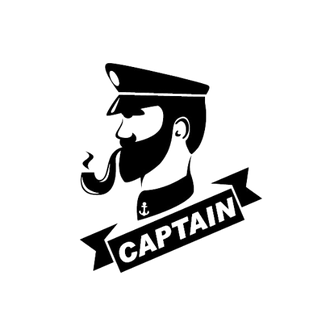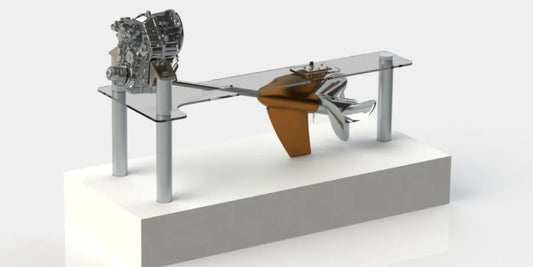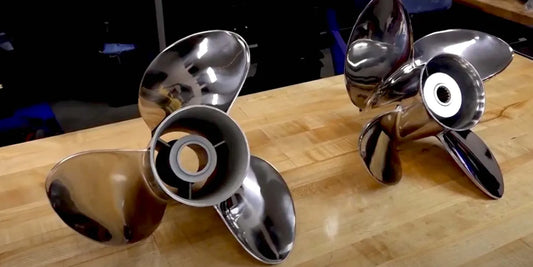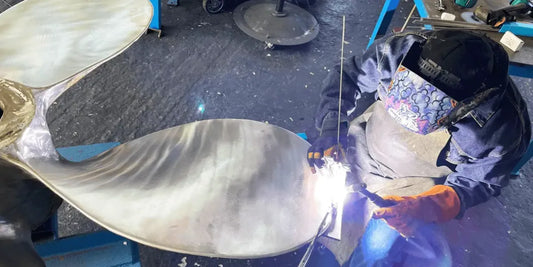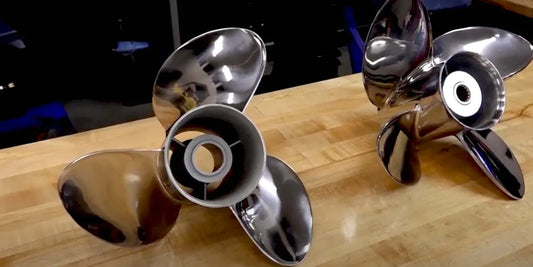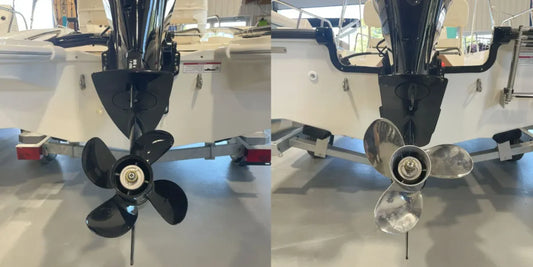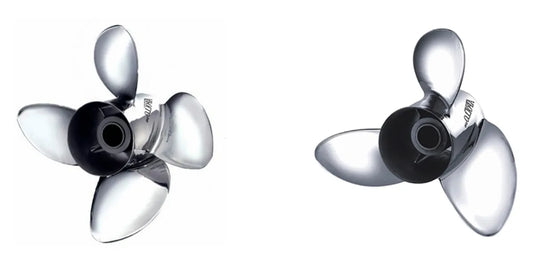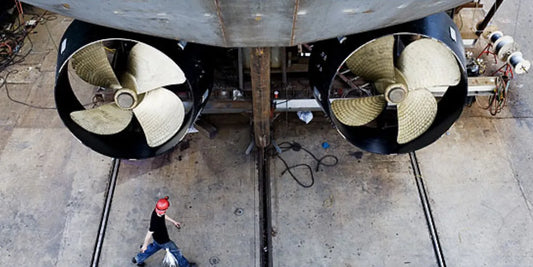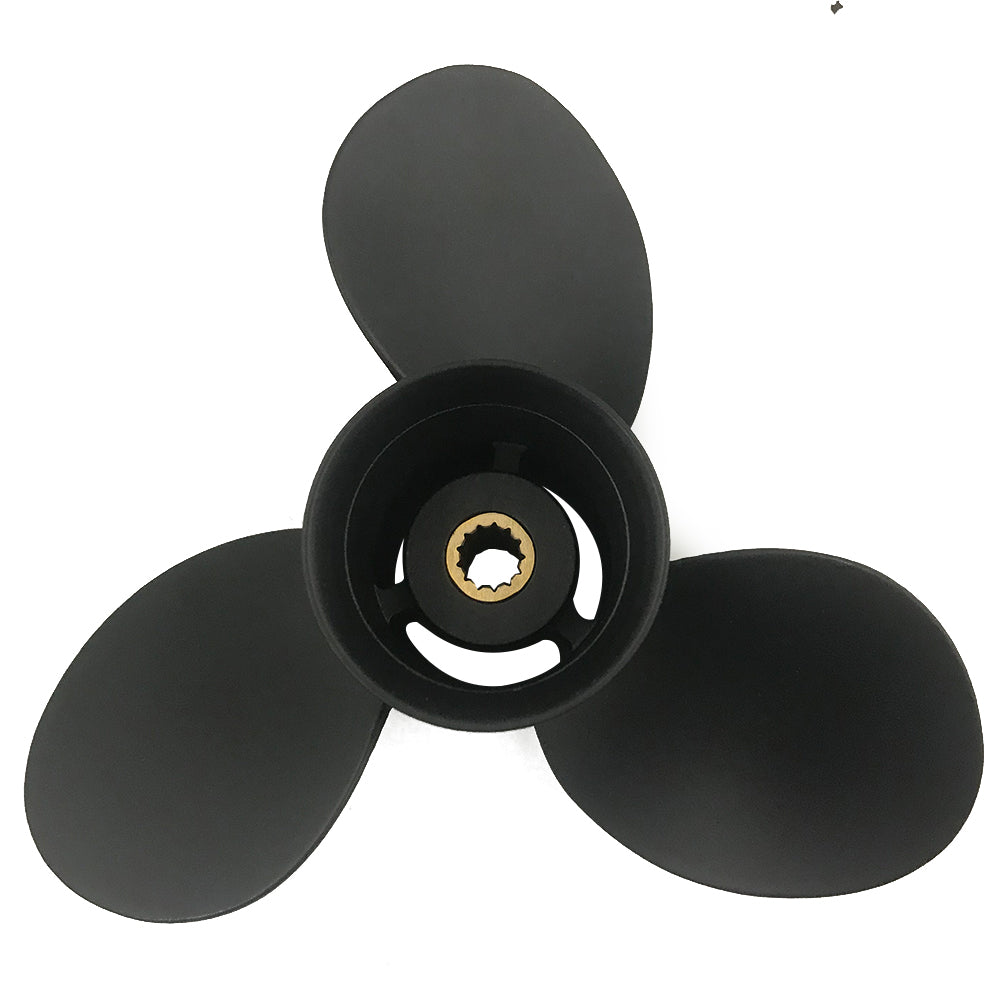Every bit of a ship plays an essential role in its performance. An interested mind would have a side view of the fact that there aren't many elements with greater poignancy than the propeller when it comes to performance parameters for a vessel. The sort of boat propeller one decides on will be consequential to speeding up or slowing down their vessel; they will also find the same factor affecting efficiency, fuel consumption, and handling ability. There are so many to choose from; the differences can become mind-boggling when the critical consideration is how to balance performance with issues of sense. In this article, we will examine the distinguishing factors of various boat propellers and analyze how these factors impact experiences downstream. Whether you want to speed your craft as quickly as possible as a professional or simply enjoy smoother rides as a recreational experience, this book will prove invaluable in streamlining your decision and enhancing your pleasure.
Introduction to Boat Propellers

What Is a Boat Propeller?
A boat propeller is a mechanical device that converts the engine's power into thrust, driving the boat through the water. It has multiple blades, generally two to five, arranged around a central hub. The number of blades, pitch, diameter, and even the material from which the propeller is made can determine how well and how efficiently it will work.
High-pitched propellers provide more thrust per revolution but require more engine power. These would best be suited for high-speed applications. Low-pitch propellers provide greater acceleration and are better suited for boats carrying heavier loads or those used for water skiing. They are typically manufactured from aluminum or stainless steel, with aluminum being a cost-effective and lightweight material, and stainless steel offering durability and performance, particularly in harsh conditions. Knowing these characteristics is essential for optimizing the speed, fuel consumption, and overall performance of the boat.
Types of Boat Propellers
Three-Blade Propellers: Three-blade propellers have been among the most commonly used due to their well-balanced performance, offering effective acceleration and speed, and are well-suited for recreational boats that are casually cruised or used for fishing. This design strikes a good balance between speed and thrust, offering versatility in various water conditions.
Four-Blade Propellers: The four-blade propellers consistently improve handling and offer fuel efficiency comparable to that of propellers, particularly at low speeds. They offer improved performance in rough waters and enhanced holding power during activities such as towing wakeboarders or waterskiers. Additionally, they will cancel out some vibration, resulting in a more comfortable operational feel.
Cupped Propellers: Cupped propellers have blades with slightly curved edges that allow them to mold through water with a better grip. This reduces slippage and enables greater efficiency, especially at high speeds. They find use in performance-oriented boats that require precise steering and efficient thrust generation.
High-Pitch Propellers: High-pitch propellers are designed to achieve the greatest top-end speed by displacing more water in each revolution. They require more power and are best suited for lightweight boats or boats designed for racing and high speed.
Low-Pitch Propellers: Meanwhile, low-pitch propellers are just what you need for boats that are heavy on acceleration and load-bearing. They are primarily used in boats for water sports, carrying heavy loads, or for slow and steady cruising.
Stainless Steel Propellers vs. Aluminum: Propeller types significantly impact their lifespan and performance. Stainless steel propellers maximize durability and efficiency. They operate in abrasive environments, where varying conditions cannot compromise their performance. The aluminum propellers, being lighter and cheaper, are better suited for less demanding recreational purposes.
Propellers are a world of options, and knowing more about them helps in choosing the appropriate one to suit your requirements that perform well and efficiently in conditions under various water.
Importance of Propeller Selection
The appropriate propeller ensures that your boat reaches its highest level of operation. Whatever the case may be, fuel consumption can be reduced by selecting a propeller that best fits your boating requirements; optimal engine performance and perfect handling follow. Speed, acceleration, and durability are governed primarily by propeller size, pitch, material, and the number of blades. A stainless steel propeller with low pitch is typically preferred for towing, wakesurfing, and wakeboarding, as it produces significant thrust at lower speeds. Meanwhile, an aluminum propeller with high pitch may be the better choice for high-speed cruising, as it strikes a balance between speed and affordability. Paying close attention to propeller selection ensures the highest performance, longest engine life, lowest fuel consumption, and safest boating experience.
Understanding Propeller Design and Functionality

Propeller Blades: Materials and Shapes
The paint, design, and material of a propeller determine the thrust and speed it offers. Modern propellers are made of two primary materials: aluminum and stainless steel, each offering distinct advantages. Aluminum propellers are lightweight and cost-effective, making them suitable for pleasure boats or slow-speed operations. Stainless steel propellers provide greater strength, resistance to corrosion, and are designed to withstand higher stresses, making them ideal for use on faster craft.
The configuration of blades plays a crucial role in the operation of a propeller. A typical three-blade, for example, tends to produce more speed because it experiences less drag. At the same time, a four-blade-type design is aimed at producing more thrust and smoother operations, usually suitable for watersports or towing. The blade geometry, consisting of pitch and diameter, affects acceleration, top speed, and fuel consumption. Computer-aided engineering enables the design of blades with precision, optimizing rake angle and cupping, among other factors, to enhance overall performance for specific boating applications. Through a study of propeller materials and shapes, the ultimate performance will be achieved by the end user, tailored to their specific operational requirements.
Aluminum versus Stainless Steel Propellers
Some worthwhile considerations when selecting between aluminum propellers and stainless steel propellers are the advantages specific to each type and how those advantages fit in with the boat owner's requirements. Heavy-duty aluminum propellers are generally lighter, less expensive, and more popular with casual or recreational boaters. They are best suited for smaller boats or applications where budget considerations are paramount, with good performance for the price. Aluminum is also easier to repair in the event of minor damage, given that the frequent shallow waters of most recreational routes also provide ample opportunity for their occasional damage.
Stainless steel propellers possess the strength, durability, and performance that make them famous. With their rigid structure, flexing between points of operation is minimal, thereby augmenting efficiency and speed. Stainless steel propellers are the best choice for high-performance boats or activities requiring precision and reliability, such as water skiing or racing. While stainless steel propellers cost more at first, their durability reduces the need for frequent replacement. Additionally, stainless steel propellers are often designed using sophisticated engineering techniques, featuring higher rake angles or thinner blades to enhance hydrodynamics.
Choosing a particular material comes down to balancing the performance required with the durability needs and budget. The stainless steel will come in handy, for example, if you are boating in rocky conditions, as it can save money on repairs in the long run, being much tougher than most other materials. Aluminum, on the other hand, will serve smaller boats with moderate performance needs very well, both in terms of function and cost.
How Pitch Alters Boat Performance
Pitch of a boat propeller is defined as the distance a propeller would move forward through the water in one complete revolution, if slippage is not taken into account. These are factors that influence the speed and efficiency of a ship. A high-pitch propeller means that it will travel a greater distance with each revolution; it is intended for higher speeds and lighter loads. However, if the pitch is too high, it will become less useful to the engine, resulting in slow acceleration due to the engine having to work too hard.
In contrast, a low-pitch propeller offers greater acceleration and torque, which are useful in activities such as water sports or carrying heavier loads. Doping into triglyceride-rich low-pitched propellers decreases top speed because the engine reaches maximum RPM faster. A propeller must always be selected based on pitch to keep the engine within its recommended RPM operating range, delivering good performance without undue wear on the engine. For example, an incorrectly pitched propeller might cause "under-revving" or "over-revving," both of which shorten engine life and reduce efficiency.
Boat size, engine power, and primary use should be among the key considerations when making a decision on pitch selection. Testing out and adjusting pitches will help optimize speed, acceleration, and fuel consumption for every particular boating application.
Inboard vs. Outboard Propellers

Variations in Propeller Design
The design of an inboard and an outboard propeller differs significantly due to the operational conditions. An outboard propeller is mounted on the shaft and directly connected to the engines at the back of the boat; these types of propellers are designed for quick acceleration and handling. Racing outboard propellers are generally lighter and offer a variety of pitches suitable for watercraft size and speeds. Their goal is to enhance versatility and ease of installation, which is particularly beneficial for smaller boats used for recreational purposes and fishing.
The propellers that fall under the inboard category are located under the hull and connected to the engine by means of a shaft. They were designed for durability and efficiency, generally larger in diameter, with blade designs that handle more horsepower. Their placement lowers the center of gravity and reduces drag, offering stability and improved performance in larger vessels, such as yachts and commercial ships. There is a slight difference in materials used: outboard propellers frequently use aluminum or stainless steel, while inboard propellers tend to use bronze or other highly corrosion-resistant alloys so as to resist prolonged exposure to marine environments best. Another noteworthy component in the inboard setup will be selective, sophisticated propeller optimization that allows for specific speed, thrust, and maneuverability requirements relative to heavy-duty applications.
Effect on Speed and Efficiency
Depending very much upon the nature of outboard and inboard propellers employed, a vessel may achieve varying speeds and efficiencies. Outboard propellers, usually designed for light and fast boats, tend to maximize top speed with little regard for fuel efficiency. Being small and spinning at a higher rpm, they favor rapid acceleration and nimble handling, which is best suited to either small recreational boats or fishing boats.
On the contrary, an inboard propeller is primarily oriented towards generating more thrust and stability; hence, they are chosen for larger boats or boats that require heavy-duty performance. Inboard thrusters are most effective at slower speeds, particularly when towing or carrying heavy loads. Furthermore, modern hydrodynamics and suitable materials help reduce drag and enhance the propeller's overall efficiency. For example, highly cupped blade edges or variable pitch designs can result in smoother inboard propeller operation, and this single characteristic stands out in their ability to adapt to changes in water conditions.
Industry case study data indicate that a ship with a duly calibrated inboard system has at its disposal the capability of slashing fuel consumption by up to 15% compared to a traditionally designed one, which is a significant help in determining operational efficiency. In commercial shipping or long-range maritime activities, the most important impact and the most valuable prize is operational costs.
Right Selection of Prop for Your Engine Type
Choosing the right propeller for your engine type is an essential prerequisite for achieving optimal performance, fuel economy, and functionality. It ensures that the engine is running at its ideal RPM and not below it, even under load or stress. An important factor is the engine's horsepower, as well as the intended use of the boat (for fishing, water sports, or cruising), and a consideration of the vessel's size and weight.
Propellers with more pitch are favored in applications optimized for higher speed, as an increase in pitch speeds up the movement of the boat per rotation of the engine. A lower-pitch propeller, on the other hand, can create torque and is best suited for towing or heavy loading. Another aspect involves price and durability, comparing anodized aluminum versus stainless steel: the former is cheaper and more dependable, while the latter offers stronger resistance and performance but at a higher price.
Data also indicate that blade count and design are essential factors. Three-blade propellers are typically associated with a compromise between speed and efficiency, while the four-blade counterpart offers more stability and better fuel economy at slower speeds, making it preferred for heavier boats or rough waters. After a careful review of these parameters and testing their measurements on the road, boat owners will be able to secure that their chosen propeller suits both their engine and boating requirements, thus enhancing the handling and overall operation of the vessel.
Factors Influencing Propeller Performance

Boat Weight and Size Considerations
The weight and size of a boat have a significant impact on propeller performance in general. Heavier boats, such as freight and large passenger craft, are built to thrust at a lower pitch so that thrust serves to resist the relatively smooth glide of the craft through water. This helps in faster acceleration and less stress on the engines. The diameter of the propeller is usually large for heavier crafts, allowing it to displace more water and maintain performance against load. In contrast, high-pitch propellers are ideal for relatively low-weight and small-sized craft à la speed boats or recreational crafts for speed and agility.
From an academic perspective, based on marine works studies and user data, it appears that precisely sizing and setting the propeller with respect to the boat's dimensions ensures better fuel consumption, accommodation, and engine stress considerations. If, for some reason, the owner chooses a small propeller for a huge boat, cavitation occurs: air bubbles form around the blade. The air bubbles interfere in some way with the speed and control of the ship. Knowing well the boat's weight and size in relation to the propeller arm can hence help an owner determine the best choice for maximizing performance under different operating conditions.
Engine Specifications: V6, V8 and 450-HP Option
The new generation V6 and V8 engines, or the 450HP options, offer unparalleled power and versatility needed for various waterborne activities. The V6 engines are best known for their balance of fuel economy and performance, providing a smooth-running operation to complement more relaxed cruising or recreational use. The V8s, on the contrary, deliver high torque and acceleration, making them apt for power-bearing, larger crafts or speed-focused watercraft. In times when horsepower is most needed, the 450 HP units are designed for the most heavy-duty requirements, with rapid top-end speeds and steady output under enormous loads. These engines are usually updated with state-of-the-art technologies like variable valve timings, direct injection, and the like for efficient performance in each of its workings and in durability. The boats are equipped with a variety of engine options, allowing for customization of the propulsion system to meet specific needs without compromising engine performance in different environments.
Conclusion: Maximizing Your Boat’s Performance

Recap of Key Takeaways
In the matter of boat-performance optimization, I have learned that the proper selection of an outboard motor is of utmost importance. Efficient engines, coupled with advanced technologies such as variable valve timing, direct injection, and enhanced cooling, will offer the perfect blend of power, efficiency, and reliability. Each of these features ensures the engine will provide a smooth and consistent performance under varying, demanding conditions, thus rendering the boating experience less tiresome and enjoyable for me.
Another thing I’ve learned is that adaptability is key. Modern outboard engines are designed to meet a range of specific needs, allowing individuals to select the propulsion system that best suits their boating style and environment. Whether the need is speed, fuel economy, or ruggedness, the right engine will ensure that one never has to compromise. Keeping these vital things in mind helps me make informed decisions about upgrades to my boating experiences, considering all the technical aspects that come into play.
Final Tips for Choosing the Right Boat Propeller
For me, selecting an appropriate boat propeller means finding the right balance of power, speed, and efficiency. I always start by figuring out specific performance goals that I want to achieve. Sometimes, I want more acceleration; sometimes, higher top speeds are necessary; and at other times, better fuel efficiency is on my mind. Whatever the cause, having defined priorities makes it easier to eliminate a bunch of options. The next consideration is the prop size and pitch. A good balancing act ensures that the prop size matches the actual specifications of the engine, delivering performance while minimizing undue strain on the motor.
Another important consideration is material selection. Aluminum propellers strike a balance between cost and strength, making them convenient for everyday use. However, for high-performance boating or in more adverse conditions, stainless steel propellers are my preferred choice, given their additional strength and wear-resistant nature. Blade count is a key consideration; fewer blades provide for speed, while more blades offer smoother handling and control in rough waters.
While doing so, I make adjustments and try new setups dictated by real boating conditions. Many a time, trial and error allow me to tweak a performance to suit my needs, whether going through shallow waters or speed boating. Investing time in research and testing makes a significant difference in propeller choice, and ultimately, a boat that performs and is reliable in all respects.
Future Trends in Boat Propeller Technology
In my opinion, boat propeller technology is an exciting field for the future, with numerous enhancements focused on improving efficiency, durability, and environmental impact. A notable trend that I have observed is the increasing use of the latest materials—primarily carbon-fiber composites and lightweight alloys. Through their effect on performance, which involves opting for greater speed and reduced fuel consumption, these materials also exhibit enhanced corrosion and abrasion resistance. Consequently, given their long-term usability in different water conditions, they are highly preferred.
Yet another enticing innovation would be the inclusion of an intelligent system in propeller operations. In other words, the propeller uses some combination of sensors and automated adjustment mechanisms to adapt to water conditions being experienced at a given time, to optimize performance; thus, a smart propeller can alter pitch and blade angles for maximum efficiency whether cruising on fast-moving waters or on slow-moving canals; adaptability simplifies operation and improves fuel efficiency while reducing engine strain.
Another trend is sustainability. Increasing environmental awareness has prompted designers to explore greener areas, such as quieter propellers that minimize noise pollution and models that reduce underwater emissions. I imagine that with the advancement of technology, there will be more ways to balance good performance with environmental stewardship, providing enjoyable experiences for all. We are certainly in exciting times for an industry that is shifting and morphing!
Reference Sources
-
Understanding the Different Types of Boat Propellers - Discover Boating
Explains common propeller types, including three-blade and four-blade props, and their balance between speed and fuel efficiency. -
Understanding Boat Propeller Types - Michigan Wheel
Discusses custom-designed propellers and their impact on speed and fuel consumption. -
Props 101: The Ultimate Guide to Boat Propellers - Wakemakers
Covers how different propeller pitches affect performance for various boating activities. -
7 Different Types of Boat Propellers - Alberni Power Marine
Provides an overview of propeller classifications, including blade shape, pitch, and materials. -
Props 101 - Learn The Basics About Performance Propellers - BBlades
Offers insights into how propellers transfer engine horsepower to water and their role in performance.
Frequently Asked Questions (FAQs)
What Is a Boat Propeller and How Is It Able to Work?
The propeller of a boat is a highly vital part of the propulsion system. It consists of blades rotating to drive water backward, thereby forcing the boat forward. The performance of such a piece is governed by its pitch, diameter, and number of blades. For instance, a high-pitch prop will probably offer a better top speed, whereas a low-pitch prop would provide a faster acceleration. Would knowing the mechanics help the boater choose the proper propeller for their needs?
How to Choose the Right Prop for My Boat?
With prop selection, you must consider the engine horsepower (hp), the type of boat, and its intended application. The pitch and size of the propeller should ideally be suited to the ship for the best output. The dealer or prop shop can provide you with valuable information regarding all the possibilities. Mercury Marine and Powertech propellers also come in different variants to suit your choice of boating experience, so you will surely find the propeller that fits your specifications.
What is propeller pitch, and why is it important?
Propeller pitch is the theoretical distance a propeller would move forward in inches in one complete revolution. It substantially influences the speed, acceleration, and performance of the boat. A higher pitch might compromise hole shot and acceleration, but allows for higher top speeds. On the other hand, a low pitch will be beneficial for towing or skiing, as it provides quicker acceleration. Understanding propeller pitch is necessary to fine-tune your performance profile depending on the activity.
What materials are used to make boat propellers?
Boat props can be manufactured from a variety of materials, including aluminum, stainless steel, or specialized materials for high-performance applications. Aluminum props are the cheapest and also lightweight, thus suitable for every casual craft. On the other hand, stainless steel props are designed for heavy-duty applications and to operate efficiently at high RPMs. Companies like Solas and Bravo offer both, allowing the boat owner to choose based on performance demands and price. One must consider the material, as it affects fuel economy and vibration levels during operation.
How do I know if my propeller is bent or damaged?
Regularly inspecting your propeller helps in keeping optimum performance. Damage may be dents, cracks, bent blades, craters from cavitation, or just not performing to the rated efficiency. Additionally, if you start experiencing odd vibrations or changes in handling from your boat, that can be a symptom of the propeller being in trouble. If your prop is damaged, it is essential to consult with a dealer or prop shop to determine if the prop can be repaired or if it needs to be replaced. The better condition your propeller is in, the better your boating experience will be.
What factors affect the performance of my boat prop?
Several factors affect the performance of your boat prop, including pitch, diameter, material, number of blades, engine rpm, and the type of boating you do. A well-matched pitch will give an underpowered boat better acceleration and overall performance. Other factors, such as propeller rake and design, also tend to affect prop performance at WOT. A knowledge of these factors will help you make better decisions on your prop selection and modification.
